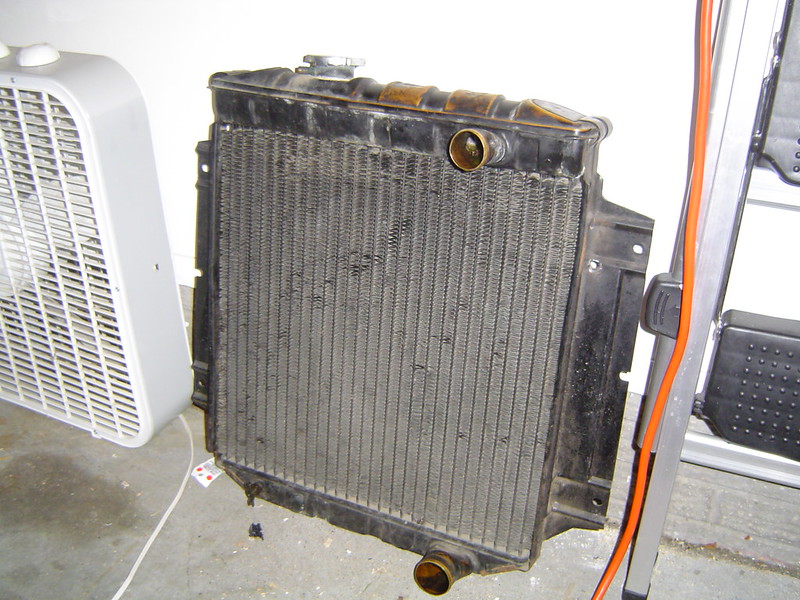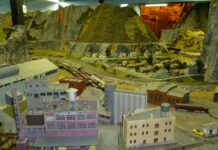
Soldering radiators is an important component of radiator repair and requires precision and skill. To ensure a success, it is necessary to select the best solder for radiator repair jobs. A good acid core solder — a 50/50 or 40/60 lead solder — have done well for me in the past.
What is the best solder for repairing a radiator?
- Acid and petroleum based
- Petrolatum based
- Contains 2 ounces
- Country of Origin:United States
- AIM 40/60 is an general repair flux core solder wire with a diameter of 0.125" / 3mm cored with 2% acid flux.
- AIM Solder is one of the most renowned solder manufacturer worldwide and offers outstanding quality.
- This item is popular due to it's 40% lead and 60% tin alloy that gives a low melting temperature of 183°C - 247°C (361°F - 477°F) and smooth flow.
- Used for general purposes such as sheet metal joints, radiators, gutters and other jobs
- Not made for electrical or electronic applications
- The ideal flux for plumbing and general soldering
- Contains 2 ounce in a "hockey Puck" jar
- Not for electronic applications
- Ideal for copper, brass and ferrous alloys.
- Acid liquid cleaner for non-electrical applications
- 3 ounce squeeze bottle
- AIM Generasol Lead-Free is an general repair solder wire with a diameter of 0.062" / 1.5mm cored with 2% acid flux.
- AIM Solder is one of the most renowned solder manufacturer worldwide and offers outstanding quality.
- This item is popular due to it's silver bearing lead free alloy, low melting temperature and smooth flow.
- Used for general purposes such as sheet metal joints, radiators, gutters and other jobs
- Not made for electrical or electronic applications
- Used for non-electrical applications
- Great for sheet metal joint and fitting connections
- Works well on many types of metals including copper, brass, nickel and galvanized steel
- 1/8-inch x 1/4-pound
- Petrolatum based
- Contains 16 ounces
- Acid and petroleum based
- Included components: Flux Paste
- Wire solder containing acid flux core
- 40/60 alloy made of 40% tin and 60% lead
- Great for repairing galvanized gutters and filling metal seams
- General use solder
- 361-460F melting range
- ENOUGHT QUANTITY: The package includes 2 jars of soldering flux. A total of 70 g. Enough quantity for your use.
- NON-CORROSIVE: Rosin is not conductive in dry conditions and has good insulation. Is not corrosive to metal substances such as circuit boards.
- OXIDATION RESISTANCE: Anti-oxidation effect on soldering iron head of gold-copper alloy substrate. Solder flux for semi-solid, not easy to dump.
- STRONG APPLICABILITY: Flux is suitable for welding instruments, gold, copper, tin, iron and other metals. Ideal for electronic welding, repair and rework.
- WHAT YOU GET: Rosin soldering flux paste * 2, our 7*24 friendly customer service for peace of mind.
- GOOD QUALITY:High Level Electronical Solder ability both in electrical conductivity and thermal conductivity;With the solder wire reel, soldering can be accomplished quickly.
- SUITABLE:General purpose solder for sweat fittings,sheet metal joints,gutter work and other big jobs.
- FIT:This Solder Wire works well on galvanized sheet metal,copper, steel, plate,brass and tin plate it's often used on radiators.
- FIT:This Solder Wire works well on galvanized sheet metal,copper, steel, plate,brass and tin plate it's often used on radiators.
- PACKAGE INClUDED:1 x Solder Wire Reel.
Affiliate links / Images from Amazon Product Advertising API
When attempting to repair or replace a radiator, one of the most important things to consider is the type of solder best suited for the job.
The challenge often lies in having the right solder for each job. From understanding flux types and solders, to identifying potential problems and protections, this guide will outline the basics of soldering a radiator repair.
Flux Types: There are two main types of flux used when soldering radiators – acid and rosin core solder.
Acid flux is an activated glue which When heated releases a chemical reaction that enables a cleaner metal joint that lasts much longer than other forms of flux.
Acid based flux helps protect metal against future corrosion and it also helps provide a stronger bond between two metal parts while simultaneously reducing oxidation buildup on metals during soldering. Rosin core solder contains both components – the active additive (rosin) as well as actual solder material – which means it can be used as both a flux activator and as filler material in larger joints/connections during soldering work on radiators.
Solder Types: There are several different kinds of solder available for radiators repairs. The most common types are:
- Silver-bearing soft solder
- Aluminum-based softer brazing alloy
- Copper bearing hardened brazing alloy
- Copper carbide brazing alloy
- Silver-bearing hard brazing alloy
- Stainless steel filler metal brazing alloy
Each one has advantages depending on what you need from your repair from strength to temperature resistance thresholds—take your time when choosing which type is best for you before you begin your work!
What kind of JB Weld do you use for radiators?
- RADIATORWELD: Our radiator and plastic tank repair kit has all you need for making professional quality, permanent repairs with state of the art components and easy to follow instructions.
- COUNT ON US: For more than 40 years, our products have earned a loyal following from people who take pride in their work. With each product we innovate, we continue to provide the world's strongest bond for your projects.
- SIMPLE TO USE: No removal of tank or radiator is required to stop leaks. Easily fix holes up to 3/8" diam. or cracks up to 4" long. Includes epoxy putty, fiberglass cloth, sandpaper, and applicator.
- VERSATILE & DEPENDABLE: Great for radiators, washer fluid tanks, storage tanks, water tanks, plastics, composites, PVC and more. Professionals, mechanics and avid DIYers know J-B gets the job done.
- NO PROJECT TOO BIG OR TOO SMALL: We have all the products you need to get the job done right. JB Weld always delivers the legendary performance of the World's Strongest Bond.
Affiliate links / Images from Amazon Product Advertising API
This JB Weld can be used for radiators. It is specifically formulated to repair them.
Tips for soldering a radiator
When soldering radiators, the melting point of the solder being used should be above 90% of the operating temperature range of the radiator.
This will ensure that it melts at the required temperature during operation and does not cause thermal stress on any other nearby objects.
Generally, most radiator repairs require a soft or medium brass- or silver-based solder for best results; however, different types of solder may be required depending on the materials in which they are to be applied.
What is the best solder for automotive use?
It is also important to use flux when soldering radiators.
Flux helps to reduce oxidation and promote strong bond formation between metal surfaces as well as making soldering easier by removing oxides from metal surfaces.
Using an acid core flux designed for copper-based alloys is recommended when soldering radiators that use this material combination since this type of flux reacts faster with copper alloys, promoting a quicker bonding process thereby increasing the speed and safety of your repair job.
Different Types of Solder for Radiator Repair
Solders come in many varieties and selecting the correct one for a radiator repair is essential to ensure that the job is done properly.
The type of solder used will depend on the material of the radiator being repaired, as some solders are better suited for specific materials than others.
Commonly available solders include soft lead solder, silver solder, copper phosphorus silver solder, steel pipe flux cored wire and non-corrosive fluxes. To determine which type is most appropriate for your radiator repair, read through this guide:
- Soft Lead Solder – Soft lead solders are well-suited for repairing leaks in copper or brass radiators as they can create a tight bond between two similarly smelted materials. These types of solders are typically composed mostly of tin but can also contain other metals such as antimony or copper which gives them their unique workability and strong joint hold strength.
- Silver Solder – Silver solders work best with copper or brass components because they create a tight bond when alloyed with these such metals combined with heat. While this type of solder is more expensive than other varieties it offers superior strength so it’s often preferred by professional mechanics for taking care of jobs like radiator repair.
- Copper Phosphorus Silver Solder – Copper phosphorus silver solder (CPSS) uses an element called phosphorous which actually aids in breaking down oxidized surfaces making it perfect for use in radiator repairs that involve pitted or corroded pipes or connections. CPSS sprinkles easily and results in those repairing radiators to have faster work times; however, using too much phosphorous can be damaging so caution must be taken when using this type of solder for these types of jobs.
- Steel Pipe Flux Cored Wire – This special wire allows mechanics to weld steels without having to use extra supplies like flux as it comes pre-fluxed in its core; hence its name ‘flux cored’ wire! This specialized kind works best on thinner steel pipes which makes it especially suitable for radiators repairs where space is limited by cramped engine compartments found inside vehicles today due to their ever-decreasing sizes!
- Non-Corrosive Fluxes – Non corrosive fluxes contain chemicals that can react chemically with the surface and base metals being joined together resulting in a strong bond almost immediately although these tend to not last as long so they should only be considered in repair jobs where fast completion time is more important than longevity. An example of this would be emergency car heater repairs during cold winter months when occupants need relief from lower interior temperatures quickly!
Pros and Cons of Using Solder for Radiator Repair
When repairing a radiator, you want to make sure that you use the right materials to ensure a reliable repair.
Solder can be an effective option when it comes to repairing a radiator. In this article, we will look at the pros and cons of using solder in radiator repair and provide some tips for successful soldering.
Advantages of solder
Solder is relatively cheap and easy to acquire. It also produces strong bonds that are resistant to heat, making it ideal for permanently sealing any holes inside a radiator housing.
Additionally, solder can be used in combination with other materials such as steel or brass and can be used on other surfaces such as cast iron or aluminum with optimal results.
Disadvantages of solder
Soldering radiators does require some skill and experience so if you’ve never used solder before then it might not be the best option for you.
Applying too much heat can cause the solder to become brittle or break off so careful temperature control is necessary for obtaining optimal results.
Another potential downside of using solder is that it often produces an unsightly finish which may not be desirable in some scenarios.
Tips for successful soldering:
- First, ensure the area you’re working on is free of dirt and debris which could interfere with your workmanship.
- Next, clean off any corrosion or rust that may have accumulated on the outside of your radiator housing before beginning your work – this will help create a stronger bond between your solder and its surface when making repairs.
- Finally, use flux along with the solder to better protect against oxidation and contamination while simultaneously promoting adhesion against metals like steel or brass.
With these tips in mind, successful soldering should become easier to accomplish on most metals found inside radiators today!
Preparing the radiator for good solder
Before soldering a radiator, careful preparation must be done to ensure the best possible repair. Start by draining the coolant from the radiator and then rinse the unit thoroughly with warm water. Pay special attention to the areas that are going to be soldered, as they should be completely clean.
After rinsing, use an air compressor or a soft brush and rag to remove any remaining dirt or debris in order to create an even surface for soldering.
Next, use a chemical cleaner or wire brush to remove any rust that may have formed on the surface of the metal. Be sure not to scratch or damage the metal during this process, as it could affect your repair job and weaken your solder joint. Once you’ve finished cleaning, inspect the area for cracks or other damage and make sure all pieces fit properly before you start soldering.
Finally, apply flux designed for use with hot-dip soldering before heating up your equipment. Flux helps prevent oxidation of your solder joint and allows for an optimal bond between metals without creating excess heat.
Steps for soldering a radiator
Soldering a radiator is relatively simple, but it needs to be done carefully to ensure that the connection is properly sealed and free of any leakage. To properly solder a leak in a radiator, you’ll need the following materials: propane torch, flux paste, silver bearing solder, electrical tape and heat shrink tubing.
Here are the steps you need to follow:
- Clean the area around the leak with sandpaper or a wire brush.
- Apply flux paste to both sides of the leak and let it sit for an hour or two.
- Fire up your propane torch and use a medium flame to heat up the area around the leakage until it reaches soldering temperature (around 450 °F).
- Melt some silver-bearing solder onto your iron tip just before touching it to plates/trough that has been heated with flux pastes.
- Feed solder wire into both sides of joining plate/trough in order to create a strong bond between them and complete enclosure of area being worked on.
- Let cool for few minutes before proceeding with next step – wrapping connections in electrical tape or heat shrink tubing so as to better isolate from external environment & prevent moisture from inside seeping outwards further corroding already existing connections/plates further down line even if repair takes place perfectly first time around (important!).
Safety considerations When soldering a radiator
When soldering a radiator, there are several safety considerations to keep in mind.
Most importantly, ensure that the area is well ventilated as it can be easy to become overwhelmed by fumes.
Wear protective clothing, such as long-sleeved overalls and big gloves, and be sure to wear safety glasses when dealing with molten metal. It is also advisable to have a fire extinguisher nearby in case of emergency.
The best solder for radiator repair should be lead-free (which is more expensive than lead-based). Certain fluxes should also be avoided, as they can potentially corrode the radiator if not used correctly.
If you are an experienced do-it-yourselfer, then a rosin based core solder is generally recommended for radiators; however, for beginners it is best referred to consult with a professional plumber or heating technician for advice on what type of solder will work best with your radiator.
Tips for Soldering a Radiator
When it comes to soldering a radiator, there are several tips you should keep in mind to ensure a safe and successful repair.
- Form a joint before any solder is applied in order to minimize the stress on the pipe. This is done by forming an overlapping lip between two pieces of material before soldering them together. Use a soft metal pipe brush to clean the surface where they overlap and apply a flux paste along any old joints that may have been damaged or corroded.
- Choose the right type of solder. You should always use one with a low melting temperature such as lead-free or rosin core solder as these create less strain on the pipe when melted. This ensures that any weakened joints will not crack or break when exposed to heat during soldering. Additionally, silver-bearing solder can create corrosion problems if not alloyed properly with other metals like brass and copper.
- Avoid too much heat. Too much heat can cause damage to a radiator as well as ineffective soldering techniques; both of which can result in costly repairs and replacements. To avoid this, use tools like heat sinks, protective clamps, and tongs designed specifically for working with hot metals or pipes.
- Test the joint. Always test your soldered joint by running cool water through it before reinstalling the radiator – this will tell you whether or not you need additional reinforcement due to weak bonds or faulty seals.
Find the best solder for radiator repairs on Amazon.
Originally posted 2023-01-28 22:23:34.


